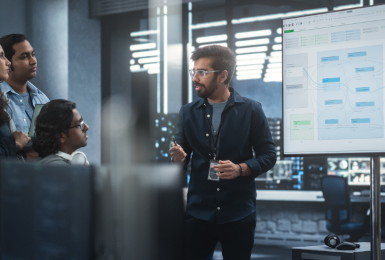Even if you are largely unfamiliar tech industry processes, you might be aware that professionals called developers are responsible for designing and maintaining all kinds of software. However, many outside the industry lack an in-depth understanding of what this “design” and “maintenance” entails.
What does a software developer do, then? Before we answer this further, it may be helpful to define exactly what a software developer is.
What Is a Software Developer?
Software developers draw upon a range of coding and programming skills to create and improve software programs, applications, and computer systems of all kinds. These developers play a central role in every step of the software development life cycle (SDLC), from initial project planning and analysis to ongoing optimization and maintenance. If you’re interested in how this role compares to others in the tech field, you can explore our guide on the differences between a software developer vs. software engineer.
Types of Software Developers
Software developers can be classified according to numerous different variables. For instance, mobile developers and web developers promote themselves according to the type of software they develop.
The main industry standard, however, is to divide software developers according to their specific areas of technical focus within the software development process. With this standard in mind, you can characterize virtually any software developer as a front-end, back-end, or full-stack specialist.
Front-End Developer
True to their name, front-end developers work on the front-facing parts of software applications, websites, and systems. This means they deal with software elements that users can see, hear, and interact with. Examples of front-end software elements include clickable buttons, text fonts, images, graphs, music, videos, and general application/website color schemes. Front-end developers often work with HTML to establish basic website structure, CSS to create website aesthetics, and JavaScript to drive interactivity. Ease of navigation and overall user experience (UX) are key front-end development concerns.
Back-End Developer
Primarily focusing on server issues, back-end software developers handle the aspects of applications and websites that are invisible to users. And though they don’t see back-end development elements, users can certainly feel their effects. Working with elements such as application programming interfaces (APIs) and both traditional and cloud-based databases, back-end developers ensure that software functions as it should, prevents downtime, and operates free of glitches and bugs. Beyond HTML, CSS, and JavaScript, the average back-end developer will likely use Python and Hypertext Preprocessor (PHP).
Full-Stack Developer
Performing both front-end and back-end development tasks, full-stack developers work with both the visible and invisible components of software. While full-stack development is often quite a bit slower and can suffer from a lack of targeted expertise, it can be beneficial for a variety of reasons. For one, full-stack developers can oversee the entire development process, placing them in a great position to ensure that front-end and back-end operations support and complement each other. Furthermore, full-stack developers have a diverse skill set that promotes flexibility, efficiency, and cost savings.
What Does a Software Developer Do?
What is a software developer’s daily duties? Noting the significant breadth and depth of SDLC processes, the United States Bureau of Labor Statistics (BLS) lists diverse software development job responsibilities — from analyzing initial user needs at the beginning of a project to monitoring and maximizing the performance of software in operation. Below are brief explanations of the most common duties of modern software developers.
Design Software Applications and Websites
In the words of the IEEE Computer Society, software design is “the process of transforming user requirements into a suitable form, which helps the programmer in software coding and implementation.” This typically involves the creation of a software requirements specification (SRS) document that clearly delineates all project needs, objectives, and guidelines. The SRS document serves as both the blueprint and the roadmap for a software project, specifying its underlying structure as well as its path to completion.
Write and Test Code
Writing code and testing code must go hand in hand if you want to effectively detect and address bugs and glitches in your software. “Each time you find a bug in your code, you should write a new test to assert that the code works correctly,” states the software development collaboration platform GitHub. “Once the bug is fixed, this new test should pass and give you confidence that the bug has been fixed.”
The close relationship between writing code and testing it is epitomized in the test-driven development (TDD) approach. TDD involves repeating the following three steps until the project is complete:
- Writing a coding test that is expected to fail.
- Developing code to address that test.
- Making ongoing code quality improvements.
Collaborate With Teams
Even the most versatile of software developers can benefit from the unique expertise and perspective of others in the field. The sheer amount of work needed to create and optimize software is generally more than a single software developer can handle. For these reasons and more, collaboration among software developers is a must.
“Collaboration is a crucial driver of developer productivity, as it fosters an environment where knowledge-sharing, problem-solving, and innovation flourish,” writes Taylor Bruneaux of the software development platform provider DX. “When developers collaborate, they combine their unique skills and perspectives to tackle complex problems more efficiently than any individual could alone. This synergy accelerates the development process and enhances the quality of the software produced.”
Maintain and Update Software
Although it may be tempting to celebrate the launch of a software program as the end of the development process, that program will almost certainly require modifications and updates to ensure it is best meeting the wants and needs of its users. This is where software maintenance comes in. A core component of SDLC, maintenance is universally and constantly necessary due to the extreme complexity of modern software applications, websites, and computer systems. A company that fails to prioritize software maintenance will likely struggle to measure up against competitors that do.
Develop Technical Documentation
Typically one of the first documents to be created in any software development project, the SRS will determine many of the documents to come. Technical documentation is essential to ensure that all project team members and stakeholders remain on the same page regarding software creation, implementation, optimization, and use.
TechTarget aptly defines the recorded information for a software project as a “living document” that must be constantly updated over the entirety of the SDLC. It expands, “Its use and the communication it encourages with users provides developers with information on problems users have with the software and what additional features they need … Developers can respond with software updates, improving customer satisfaction and user experience.”
Optimize Software Performance
We have already stressed the supreme importance of software optimization throughout the SDLC — but what, exactly, does this optimization look like? Developers can boost the overall performance of software applications, websites, and computer systems by making them operate faster, using processing power more efficiently, increasing data storage, and dealing effectively with usage spikes. For example, developers can address usage spikes through vertical scaling (upgrading existing server capacity) or horizontal scaling (distributing workload to additional servers).
Test Software
Software testing is the key to making software as good as it can possibly be at all stages of the SDLC. Just as developers should test each line of code as they write it, they should test entire software components, programs, and systems upon their completion. Testing is vital to ensure that software meets desired expectations and operates free of error before, during, and after its release and installation. Beyond pure technical functionality, testing should assess the degree to which software furthers the core objectives of those who own and operate it.
Ensuring Software Security
An essential part of software development and optimization, security involves safeguarding an application, website, or system against all kinds of cyber threats. A keen developer will strive to protect or remove all software components that are vulnerable to attack. Specific software security methods include data encryption, user authentication, and intrusion detection. To ensure airtight software security, developers should conduct regular security audits and apply any necessary security patches promptly. However, it is critical to balance security measures with positive UX. In other words, developers must take care to protect the overall performance and functionality of software as they protect the sensitive data it contains.
What Skills Do Software Developers Need?
What does a software developer do in the context of the skills they’re required to leverage? Creative thinking, analytical, and problem-solving skills are primary soft skills of the software developer. However, you must also possess a number of hard, technical skills to succeed in professional software development. The following technical areas are essential for today's software development students and professionals:
- Data structure and algorithms – A thorough knowledge of data structure and algorithms is needed to compose and organize the code that serves as the basic building blocks of software development.
- Programming languages – All software developers must be highly proficient in at least one programming language. The programming language or languages you learn should apply directly to your specific areas of software development interest. While a front-end developer will likely focus on HTML, CSS, and JavaScript, a back-end developer will want to consider mastering Python and PHP.
- Software testing – Because thorough testing is crucial throughout the SDLC, software developers must possess a solid understanding of modern testing practices and principles.
- Source control – Source control involves the tracking, management, and storage of code over time. Organizations want to protect their code and optimize changes made to that code; thus, software developers skilled in source control are in high demand.
- Databases – Because nearly all software applications, websites, and computer systems must interact directly with the enterprise database of their affiliated organizations, database expertise is essential for the modern software developer.
- Operating systems – Users must access all software applications, websites, and platforms through some sort of operating system (OS). The most common operating systems include Microsoft’s Windows and Apple’s macOS and iOS.
- Networking – Referring to the ability of software applications, websites, and platforms to connect with one another efficiently and effectively, networking is another fundamental component of overall software performance and functionality. To create, optimize, and maintain software solutions that require seamless communication among servers, databases, and APIs, developers must understand current HTTP networking standards as well as those covering Domain Name System (DNS), Internet Protocol (IP), and Transmission Control Protocol (TCP).
- Software frameworks – As sets of pre-built components, libraries, and tools that can serve as the foundation for software development, frameworks accelerate project progress by helping team members proceed efficiently and effectively. Popular software frameworks include React for JavaScript and both Django and Flask for Python.
- Debugging – Debugging is key to software optimization throughout the SDLC. To debug successfully, a developer must be adept at issue identification, problem isolation, solution verification, and code practice improvement.
- Encryption – A vital part of cybersecurity for any organization, encryption involves encoding data to prohibit unauthorized access and protect against malicious attacks. Common encryption methods include symmetric encryption (such as AES), asymmetric encryption (such as RSA), cryptographic protocols (such as SSL/TLS), and hashing algorithms (such as SHA-256).
What Education Do You Need to Become a Software Developer?
Aspiring software developers should tailor their education to match their long-term career goals. While there are many short-term certificate programs available, most employers prefer candidates with a formal college degree in software development or a related technology field.
An associate degree in software development can provide a strong foundation in programming, databases, and problem-solving — preparing students for entry-level roles such as production technician, junior developer, QA tester, or data entry specialist. This pathway can also serve as a valuable first step toward more advanced studies.
A bachelor’s degree in software development offers deeper technical training in areas like software engineering, systems analysis, cloud computing, and full-stack development. This level of education tends to unlock greater career advancement opportunities and can better position graduates for roles such as software developer, application developer, systems analyst, or engineering technician.
Whether you choose an associate or bachelor’s degree, a structured college program helps you build the technical skills, project experience, and professional credibility needed to compete in today’s tech job market.
Software Developer Career and Salary Outlook
A career in software development offers strong opportunities for growth and stability in the years ahead. The Bureau of Labor Statistics (BLS) reports that employment for software developers is expected to grow 15% from 2024 to 2034, which is much faster than the average for all occupations. This demand is driven by the continued need for new applications, system updates, and innovative technologies across nearly every industry.
Software development is also a well-paying field. According to the BLS, the median annual wage for software developers was $131,450 in 2024. While salaries can vary based on factors like industry, location, and experience, this figure highlights the strong earning potential available to professionals who build the technical and problem-solving skills employers value.
Explore a Future as a Software Developer With Champlain College Online
If you’re ready to start — or advance — your tech career, Champlain College Online offers both an online associate degree in software development and an online bachelor’s degree in software development designed to fit your schedule. Learn essential programming skills, practice real-world problem-solving, and prepare for in-demand roles across the industry. Request more information or connect with admissions to get started.






